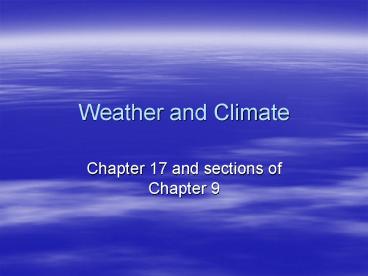Weather and Climate Chapter 17 and sections of Chapter - PowerPoint PPT Presentation
1 / 31
Title:
Weather and Climate Chapter 17 and sections of Chapter
Description:
Weather and Climate Chapter 17 and sections of Chapter 9 Atmosphere Composition Mixture of gases- 78% Nitrogen, 21% oxygen, 1% other gases. The biggest component of ... – PowerPoint PPT presentation
Number of Views:497
Avg rating:3.0/5.0
Title: Weather and Climate Chapter 17 and sections of Chapter
1
Weather and Climate
- Chapter 17 and sections of Chapter 9
2
Atmosphere Composition
- Mixture of gases- 78 Nitrogen, 21 oxygen, 1
other gases. - The biggest component of the other gases is
carbon dioxide-.3. - Oxygen and carbon dioxide are exchanged by
photosynthesis and respiration.
3
Atmosphere Formation
- The early atmosphere had mostly hydrogen and
helium. NO OXYGEN! - Volcanoes blew those gases from the atmosphere
and replaced with different gases which included
carbon dioxide. - Photosynthesis began to convert carbon dioxide
into oxygen.
4
Atmosphere Structure
- The atmosphere is in 4 layers troposphere,
stratosphere, mesosphere, and exosphere - In the troposphere, the temperature decreases
with altitude and all weather occurs here. - In the stratosphere, temperature increases with
altitude and the ozone layer is in this layer.
5
(No Transcript)
6
atmosphere
7
Heating of the Atmosphere
- The atmosphere is heated three ways radiation,
conduction, and convection - Radiation- heating using electromagnetic waves.
This is how the sun heats the atmosphere.
8
Water in the Atmosphere
- Water is present in all three states of matter
solid (ice), liquid (rain), and gas (vapor). - Water is transferred around the globe by the
water cycle. - The water is controlled by the sun and gravity.
9
Precipitation
Condensation
Evaporation
10
Evaporation
- The process where water is changed into a gas.
- This process is a cooling process where the
temperature will drop. - This puts water into the atmosphere.
- Transpiration is how plants put water into the
atmosphere.
11
Condensation
- This process converts water vapor into a liquid.
- This is a heating process. It gives off heat to
the atmosphere. - This process makes clouds.
12
Precipitation
- The joining of the condensed water molecules in
the clouds to form drops. - When the drops get large enough, it rains,
sleets, snows, hails, or a combination of these.
13
Cloud formation
- There are 3 main types of clouds
- Cirrus- high clouds- wispy and feathery looking.
Composed of ice - Cumulus- puffy clouds- usually form when warm air
is forced upward. - Stratus- layered- form where warm and cool air
meet.
14
Weather
- Weather patterns result from global patterns of
wind and pressure. - Global winds are caused by the heating and
cooling of air. - The most important to the US are the westerlies
(winds from the west) and the trade winds (winds
from the east).
15
- Westerlies bring weather from the Pacific side to
the Atlantic side. - Trade winds move hurricane systems from east to
west. - As part of these winds, high speed jet streams
control much of the storm movement.
16
High and Low Pressure
- Earths heating controls the pressure.
- The areas of low pressure have a rainy climate,
like the equator. - Areas of high pressure have dry climates like
deserts.
17
Air Masses and Fronts
- There are large masses of air above the land and
the water. - North American Air Masses
- These masses meet along front lines.
- Each type of front has different weather patterns
associated with it.
18
Types of Fronts
- Cold- cold air pushes warm air up violently-
Causes severe weather.
19
- Warm front- warm air advances and gently moves
over cold air- causes rain showers
20
- Stationary- neither warm nor cold push past each
other. Causes heavy rains.
21
- Occluded- Where 2 cold air masses meet with warm
air above. Causes rain.
22
Tornadoes
23
(No Transcript)
24
Climate
- Climate means the long-term average of weather
conditionswind, temperature, precipitation,
moisture, and other aspects of weather.
25
Causes of Climate
- Latitude- distance from the equator helps
determine temperature and amount of light - Temperature- average temp determines the types of
plants that can survive - Distance from ocean- the closer to the water the
more constant the climate. Affected by global
winds
26
- Precipitation- determines types of plants.
Highest amounts at equator. - Mountains- most rain on side of the mountain that
faces the wind. Air rises, cools and rains on
that side.
27
Types of climates
- Three major types cold, semi-arid (dry), and arid
28
Climate Changes
- Cycles of glaciations, called ice ages, represent
long-term climatic change - Last ice age-18,000-22,000 years ago
- Changes in Earths orbit are the most important
factors, producing changes that determine the
rhythmic cycles of glaciation.
29
Human Influences
- Humans may be speeding up the process by
releasing pollution that changes the climate
faster than the cycle. - The excess carbon is from burning fossil fuels
and removing vegetation. - Other gases like methane and nitrogen oxides are
also released by humans.
30
Affects of human activities
- Global warming- proposed theory that humans are
increasing the natural rate of temperature
change. Main cause carbon dioxide. - Ozone thinning- pollutants that destroyed ozone.
These pollutants are now banned and the ozone
layer is slowly recovering.
31
Explore Weather































